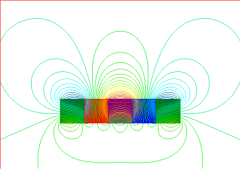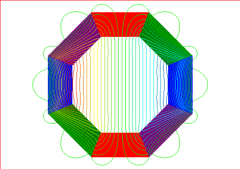Chip
Wondering Crystal

OUT OF CHARACTER INFORMATION
Intent: To make a fancy new metal
Image Source: Here
Canon Link: NA
Primary Source: NA
PRODUCTION INFORMATION
Homeworld: NA
Manufacturer: Mastercraft Alloys Ltd.
Model: Isorite Barinium
Affiliation: Closed Market
Modularity: Moderate
Production: Semi-Unique (Can only be used to create Unique Production submissions)
Material:
TECHNICAL SPECIFICATIONS
Classification: Metal Alloy
Weight: Light
Resistance:
- Blasters: Exteme
- Lightsabers: Extreme
- Plasma (non-Electromagnetic): Low
- Kinetic: Low
- Other: NA
SPECIAL FEATURES
- Highly Radioactive, but self-absorbing
- Blocks radiation from passing through itself
- Highly Magnetic
- Produces strong electromagnetic and gravity distortions
- Weakens the effectiveness of Dovin Basal Singularities projected near the metal, producing a stronger effect the closer to the metal the singularity is projected
- Distorts electromagnetic containment fields of blaster bolts and lightsaber blades, effectively curving blaster bolts around the metal and lightsaber blades away from itself
- The metal is flexible and unlikely to shatter, though it will crack under high velocity impacts
- Draws other magnetic objects towards itself (such as iron-based mass driver rounds)
- Distorts energy shielding away from itself, preventing any metal plating made from this from being shielded
- Not particularly noteworthy in terms of physical durability to kinetic and thermal stresses (Low)
- Surface catches fire when exposed to oxygen, releasing radiation and corroding the alloy
- If broken down to a molten state, releases enormous amounts of radiation
- Disrupts electronics in the metal's immediate surroundings
- Easily dented and bent
Where most applications of Isotope 5 rely upon converting the exotic metal into fuel rods and bombarding these rods with exotic particles to generate electromagnetic and gravitational fields strong enough to produce sizable quantities of power, Isorite Barinium instead incorporates the volatile, radioactive substance into a metal alloy with a number of other metals. Mixed in with this alloy is Barab, an ore known to absorb, store, and amply radiation it is exposed to, as well as Agrinium, a metal known for its outstanding ability to prevent radioactive particles from passing through it. With these two supporting elements, along with a mixture of the iron ore Magnetite, Isorite Barinium is able to relatively safely contain the more dangerous properties of Isotope 5 and creating a unique metal alloy with exciting prospects for Scientific and Military application.
Though the metal alloy itself is highly radioactive, the material is self-absorbing and blocks external sources of radiation from passing through the metal. In its solid state, this makes Isorite Barinium safe to utilize without fear of accidental radiation exposure. However, if superheated and reduced to a molten state, this metal releases enormous amounts of radiation and is extremely toxic. Complicating this hazard is the metal alloy's unique tenancy to produce a volatile chemical reaction when exposed to oxygen, producing a flame as oxygen in direct contact with Isorite Barinium is excited and burns. Somewhat alarmingly, this conflagration also causes the metal alloy to release substantial discharges of radiation while the surface is burning. Because of this, it is highly recommended that any starships plated in Isorite Barinium avoid atmospheric operation at all costs, as doing so not only releases toxic material into a planet's atmosphere, but will erode and compromise the armor plating if done frequently.
The metal itself is un-noteworthy in terms of overall durability, with the possible exception that the metal ally is more likely to dent and bend than to crack, shatter, or sheer and is no more resistant to the thermal stresses of contact with molten material than any other common steels. Additionally, the metal is highly magnetic and can cause nearby electronics to malfunction if said electronics are not properly shielded against this effect.
Of particular note, and the only truly valuable property possessed by Isorite Barinium, is the metal alloy's effect upon electromagnetic and gravitational fields. Thanks to the inclusion of Isotope 5 in the composition of this metal alloy, Isorite Barinium is capable of producing significant distortions to electromagnetic and gravitational fields. In laboratory experiments, these distortions are capable of distorting and bending the electromagnetic containment field of blaster bolts and lightsaber blades, effectively curving a lightsaber blade away from the metal alloy and radically altering the trajectory of blaster bolts (in most cases, causing the blaster bolts to 'wrap' around the metal alloy and be flung off in a random direction on the opposite side of the metal). Far less promising, but also highly interesting for scientific purposes, is the tenancy of this metal to draw other magnetic objects towards itself (such as iron-based projectiles). This warping only effects electromagnetically contained plasma, however, and does not effect the more basic plasma projectiles of most Plasma Cannons.
Also of note would be the gravitational distortions caused by this metal. Powerfully distorting, this metal significantly weakens the effectiveness of Dovin Basal singularities projected near the metal, with stronger distortions to an attempted singularity in the metal's immediate vicinity. And while tests have not been done to determine the effects of this metal upon, say, a starship's interaction with planetary gravitational fields or naval interdiction fields, test HAVE shown that Isorite Barinium, when used as starship plating, produces strong enough electromagnetic and gravitational distortions to make the use of energy shielding entirely non-functional as the shielding is distorted away from the ship itself and weakened to a state of uselessness. More alarmingly, artificial gravity used aboard said starship has been shown to produce near fatal results as constant distortions radically alter the direction and strength of artificial gravity fields in non-uniform striations. While most of the ship may function normally, bands of high intensity distortions will ripple through the ship, causing effects ranging from weightlessness to organ-crushing intensity projecting from random directions and angles.







